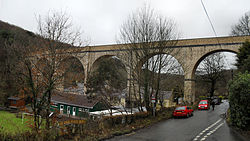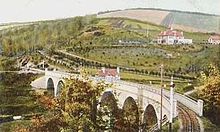- Chelfham Viaduct
-
Chelfham Viaduct 
Chelfham Viaduct (2010)Crosses Stroke Rivers Valley Locale Chelfham, North Devon Designer F. W. Chanter Material Brick Total length 400 feet (120 m) Height 70 feet (21 m) Opened 1898 Heritage status Grade II listed structure Closed 1935 Coordinates 51°06′14″N 3°59′13″W / 51.10388°N 3.98690°W Chelfham Viaduct is a railway viaduct built in 1896-7 to carry the Lynton and Barnstaple Railway (L&B) across the Stoke Rivers valley. Designed by L&B engineer, FW Chanter, and containing over a quarter of a million Marland bricks, its eight arches - each 42 feet (13 m) wide and 70 feet (21 m) high - meaning that the 400-foot (120 m)-long viaduct is the largest narrow gauge railway structure in England.[1] Chelfham Viaduct was Bridge number 22 of the 80 that carried or spanned the railway over its 19-mile (31 km) length.
Contents
After closure
After the L&B closed in 1935, the rest of the trackbed, buildings and land from the line was sold at auction in 1938. The viaduct, however, was not sold. In 1943, it featured as a location in the war-time film The Flemish Farm, representing the Franco-Belgian border. It is probable that such a redundant structure would normally have been dismantled, either then, or shortly afterwards during the war, as happened to the smaller viaduct at Lancey Brook, which was destroyed as a demolition training exercise by the Army. However, a school and other buildings at its base made it uneconomical to dismantle, so it remained in Southern Railway ownership, passing to British Railways on the nationalisation of the railways in Britain in 1948, and eventually BRB (Residuary) Ltd, formally a wholly owned subsidiary of the Strategic Rail Authority (now Network Rail). The residuary company is still owned by the UK Government and reports to the Department for Transport.[2]
Restoration
In 2000, the viaduct was extensively restored, including the fitting of a waterproof membrane to the deck, improvements to rainwater drainage, and restoration of the parapets, leaving the structure once again ready to carry rail transport. The project was funded by BRB and the Railway Heritage Trust. The L&B Project – which owns the nearby station – helped fund the upgrading of the waterproof membrane to one suitable for eventual reinstatement of the railway as part of long-term plans to reopen this part of the line to regular passenger services.
The viaduct was classified as a Grade II listed structure on 25 February 1965.
Notes
External links
Categories:- Bridges in Devon
- Buildings and structures in Devon
- Grade II listed buildings in Devon
- Lynton and Barnstaple Railway
- Bridges completed in 1897
- Viaducts in the United Kingdom
Wikimedia Foundation. 2010.


